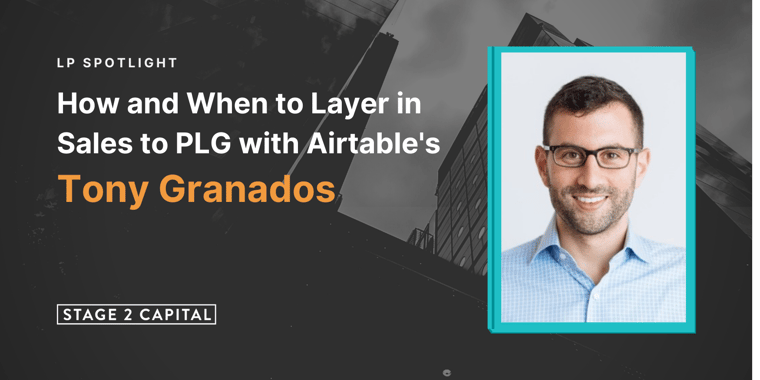After hundreds of experiments, user interviews, and segmentation analysis, your growth team finally has the PLG flywheel working. User activation is strong, WAU retention is growing, and users are monetizing with no human intervention.
Beautiful.
This is a PLG founder’s dream. At this point, the work of accelerated revenue growth begins and a common first question arises.
Does sales have a role in PLG?
Founders and boards debate with this strategic decision. Will adding sales accelerate revenue growth or destroy the magic of our PLG motion? If the former, when should sales be introduced? Did we wait too long? Should we wait longer? Who should run the team? How is the selling motion different from a sales-led growth motion?
To explore these questions, I turned to Stage 2 Capital LP Tony Granados. He successfully navigated these strategic decisions at Datadog, as Director of Global Sales Enablement, and is tackling them again as Senior Director of GTM Strategy & Revenue Operations at Airtable.
Skip to the end to listen to the video interview, or skim the key takeaways from our conversation below.
Before we dive into these sales questions, let’s lay some foundational context. What characteristics must exist for a PLG strategy to work?
“Three things. First, extremely low friction to first usage. Friction includes setup and price. Second, fast time to value. Users need to see value with no human intervention required. Third, virality. Will other people get into your product? Is there a network effect? Acquiring more users should occur naturally.”
PLG is working for your company. Do you add sales? And if so, when?
“Yes, you should add sales as a layer to supplement PLG. You actually want to add sales quite early. The first role of sales is not necessarily revenue acceleration, but learning acceleration. You want to maintain a continuous feedback loop from customers. The trick is to add sales without impacting this process.
What does an early sales hire look like at a PLG company?
“The first hire is far from a traditional seller in a sales led model. They need to support the team in understanding the customer. You need someone who can extract the value being received from your product advocates. Ideally, this person has a late-stage CSM mindset, where they can show up and speak the customer’s language. However, they also need the expansion mindset of a salesperson. It is a tricky balance, but these first few sales professionals need to constantly be thinking, ‘How can I support this individual so they can go from having one to ten seats?’”
How do you transform one salesperson into a team?
“Proof of concept. You transition from a person to a team when the goal shifts from learning to scaling. You start to see a lift [in revenue], either from your initial salesperson or the next hire. If done well, you see another lift when 2-3 more sales resources are added to the mix. That may be an indication to bring in more outside hires, who are in extremely competitive markets without significant infrastructure or support. Think of the niche players who are battling large established vendors.”
Who leads that team?
“It’s hard to find but you need a leader who has experience in a PLG environment. You want someone who is extremely entrepreneurial and believes in repeatable processes. The leader should have clarity around the mission. They have done PLG sales before, understand the process, can think critically as an entrepreneur, and understand the reality of the role he or she is in.”
What does high-velocity sales look like at scale?
“Back at Datadog, we made it very clear to our sellers that they were in a high-velocity sales role. In traditional enterprise sales, reps do all the outbound work, close the deal, and eventually expand the account. This process can take a year or more. In Datadog’s high-velocity machine, we had the AE close the deal, continue to work the deal for several months, and if they aren’t able to expand, go out and hunt somewhere else. Additionally, high-velocity sales roles were responding to marketing inbounds, PLG-surfaced leads, and doing their own outbound to named accounts. These named accounts start to look more like a traditional sales led motion, with product engagement as a simple starting point to the conversation.”
One last thing to be mindful of…
“Just like sellers can become dependent on inbound marketing leads, they can do the same thing through PLG. At a massive scale, leaders need to make sure sellers have end-to-end accountability to achieve their target, regardless of potential ebbs and flows in product-generated leads.”

